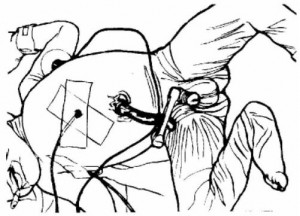a. Premature Infant.
The infant’s abdomen is relatively large, his thorax is relatively small, and his head is disproportionately large. He has poor muscle tone, but his reflexes work.
b. Postmature Infant.
The postmature infant (see figure 11-2) gestation is 42 weeks or longer. He may show signs of weight loss from placental insufficiency and in many cases the cause is not known.

(1) Characteristics displayed by the postmature infant are contingent upon placental functioning and related placental insufficiency.
(a) The infant’s skin appears pale, cracked, very dry, peeling, and wrinkled with a noticeable absence of vernix. The skin also appears dehydrated and has little subcutaneous fat, which accounts for the loose skin, especially in the buttocks and thighs.
(b) The infant’s fingernails and hair are long. There is no appearance of lanugo.
(c) The infant’s measurements are in proportion.
(d) There is meconium staining of amniotic fluid, fingernails and umbilical cord and even the skin.
(e) The infant has an alert appearance of a two to three weeks old infant following delivery.
(f) With a more severe degree of placental insufficiency, there may be asphyxia, hypoglycemia/hypocalcemia, and meconium aspiration.
(g) Other complications include pulmonary hemorrhage, pneumonia, and pneumothorax.
(2) Nursing care considerations.
(a) Observe for respiratory distress.
(b) Monitor I&O.
(c) Provide stable thermoregulation. Keep the infant warm and away from drafts.
(d) Support the parents by listening and answering questions.
